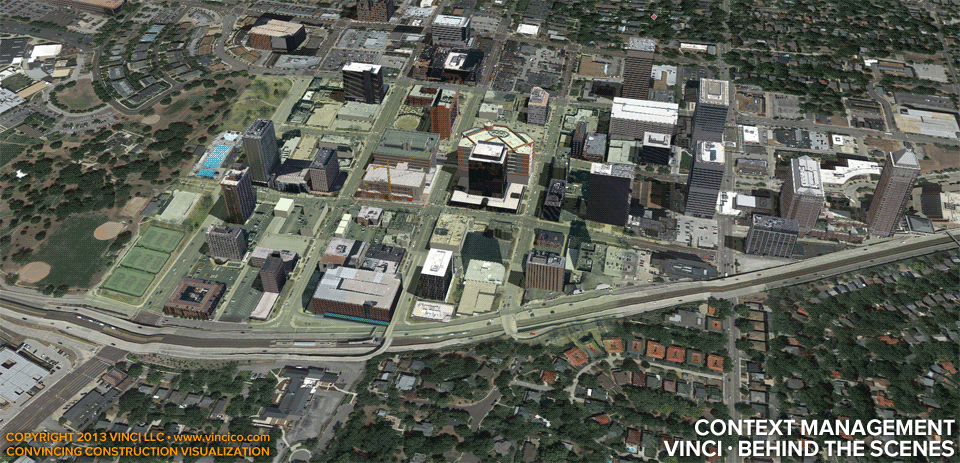 |
Vinci A90A0Urban Courthouse Addition |

Vinci LLC · Behind the Scenes | Context Management.
Context is a key ingredient in convincing virtual construction modeling, though it might seem like we can simply ignore it. It goes beyond giving the audience cues toward self-orientation during the presentation.
We all know that objects don’t hover in space like a space opera starship over a greenscreen in the movies. Buildings are built on the ground, among other structures or features. On occasion, perhaps on a rural greenfield on flat land, we might get away with ignoring context.
In an urban environment, cheek to jowl with neighboring structures, it’s harder to ignore context. It’s likewise tough to ignore context when we are expanding an existing structure. This is because the context interacts and affects construction operations, and these operations affect the habits of user groups and the community. A good construction strategy factors in the effects of operations on the community.
Thus good virtual construction modeling handles context. Surely we could model everything in the environment but it makes sense that only some objects are relevant to the message. At a certain point, the audience’s mind can fill in the rest. If a far off tower doesn’t appear in a downtown construction scene, it might not be missed. It does pay to get the adjoining neighbors, terrain, and streetscape right. People navigate their environment by landmarks large and small, especially signage. It helps to know the general story you might want to convey as you model the worksite, because you can expend more energy in areas that support a salient point, and less energy in areas that simply complete the model.
We can illustrate how construction strategy temporarily or permanently alters context. If we include contextual objects like signage, conspicuous features, and near neighbors, the audience can self-interpret the image, freeing us up to pitch our construction strategy. When you show the audience imagery that illustrates how you channel traffic during construction, they get the impression that your plan is complete and cogent. Using a virtual construction model with sufficient context, we can generate any number of user group or community relations vignettes. These are quick images from the viewpoint of pedestrians or vehicular traffic around the worksite that show your construction operations in context. These views speak directly to the people you’ll effect after mobilization. Such vignettes are powerful tools when you’re building on a campus (academic, medical, industrial, etc.) or when you need to interact with user groups or the community.
Fine-tuned, appropriate context is very important in virtual construction modeling. Because your presentations will speak to perimeter conditions and interfaces with existing conditions, your strategy will seem more complete. Through vignettes that speak to the people affected by mobilization, your strategy will appear more sensitive to such people. Your scheme will appear more grounded than those of other builders who don’t show context, or show it in a way that treats items offsite as “background”. This can be advantageous in the interview, and is certainly an asset in presentations to user groups or for community relations. Content is king, but context grounds your message, makes it real.
The above images show an urban construction project in its downtown context. The entire exurb appears in the model. Vinci LLC uses some content available from open source databases, including major improvements and terrain. This content isn't suitable for adjacent neighbors because it isn't as definite as it ought to be to interact with our worksite. Vinci LLC also uses Owner- or project-supplied datasets, especially those produced by professionals, to flesh out near neighbors. If these aren't available and given sufficient development time, Vinci LLC does produce adjacent neighbors so that we can show additions, demolitions - any construction modification to these involved major improvements. Vinci LLC also models minor improvements in and adjacent to the work zone, focusing on obstructions and signage. These items represent the traffic environment as they stand; with these we can show how our construction activity will affect that environment.
This page last modified Wednesday 25 September 2013.